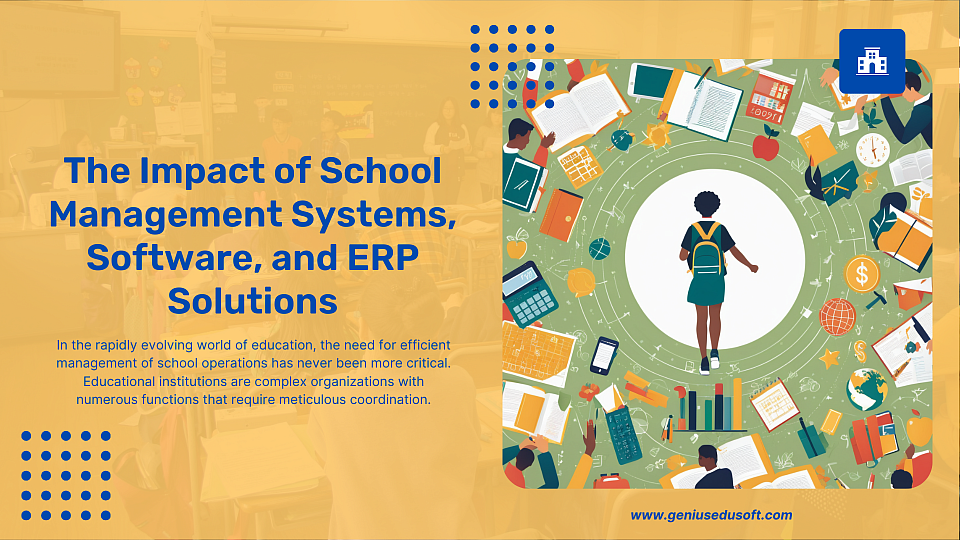Revolutionizing Education Management: The Impact of School Management Systems, Software, and ERP Solutions
Introduction
In the rapidly evolving world of education, the need for efficient management of school operations has never been more critical. Educational institutions are complex organizations with numerous functions that require meticulous coordination. The advent of School Management Systems (SMS), School Management Software, and School ERP (Enterprise Resource Planning) solutions has brought about a significant transformation in how schools operate. These systems are designed to streamline administrative tasks, enhance communication, and ultimately improve the quality of education delivered to students. In this blog, we will explore the impact of these technological solutions on education management and how they are shaping the future of schools.
What is a School Management System?
A School Management System (SMS) is a comprehensive software application designed to manage various administrative and academic functions within a school. These systems are developed to handle everything from student enrollment, attendance tracking, and scheduling to examination management and report card generation. The primary objective of an SMS is to simplify and automate these tasks, allowing school administrators to focus more on improving the educational experience for students rather than being bogged down by manual administrative processes.
The role of an SMS in enhancing educational management cannot be overstated. By providing a centralized platform where all school-related information is stored and easily accessible, these systems improve the efficiency and accuracy of administrative tasks. Furthermore, they foster better communication between different stakeholders, including teachers, students, and parents, thereby creating a more cohesive educational environment.
School Management Software: The Backbone of Modern Education
School Management Software is the backbone of modern education management. It encompasses various tools and applications that facilitate the smooth functioning of a school's operations. From managing student information to automating attendance tracking, school management software plays a crucial role in ensuring that all administrative tasks are carried out efficiently and effectively.
One of the critical functionalities of school management software is student information management. This feature allows schools to maintain detailed records of each student, including personal details, academic performance, and disciplinary history. By having all this information in one place, school administrators can quickly retrieve and analyze data to make informed decisions.
Another vital function is attendance tracking. Traditionally, teachers would manually record student attendance, which was both time-consuming and prone to errors. With school management software, attendance can be recorded digitally, with the data being instantly available for analysis and reporting. This not only saves time but also ensures that attendance records are accurate and up-to-date.
Scheduling is another area where school management software excels. Whether it's creating timetables, scheduling exams, or organizing extracurricular activities, these software solutions automate the process, reducing the likelihood of conflicts and ensuring that everything runs smoothly.
The Evolution of School ERP Systems
School ERP (Enterprise Resource Planning) systems represent the next step in the evolution of school management technology. Unlike standalone school management software, ERP systems integrate various functions within a school into a single unified platform. This includes everything from finance and human resources to student management and academic planning.
The concept of ERP in education is relatively new. However, it has quickly gained traction due to its ability to provide a holistic view of a school's operations. Historically, different departments within a school would use separate systems to manage their tasks, leading to inefficiencies and communication gaps. School ERP systems address this issue by providing a single platform where all departments can share information and collaborate more effectively.
One of the most significant advantages of a School ERP system is its ability to generate comprehensive reports. Whether it's financial reports, student performance analysis, or staff evaluations, ERP systems can compile data from various sources and present it in a format that is easy to understand and act upon. This data-driven approach allows school administrators to make more informed decisions, ultimately leading to better outcomes for both students and staff.
The Benefits of Implementing School Management Systems and ERP
The benefits of implementing School Management Systems and ERP
solutions are numerous. First and foremost, these systems improve the
overall efficiency of school operations. By automating routine tasks
and providing a centralized platform for information management,
schools can operate more smoothly and with fewer errors.
Enhanced communication is another significant benefit. With all stakeholders having access to the same information, there is less room for misunderstandings or miscommunication. Parents, for example, can access their child's academic records and attendance history at any time. At the same time, teachers can quickly communicate with parents about any concerns.
Another critical advantage is data-driven decision-making. With all school data stored in one place and easily accessible, administrators can analyze trends, identify areas for improvement, and make decisions based on accurate, up-to-date information. This leads to better resource allocation, improved academic outcomes, and a more efficient school operation overall.
Cost savings are also a significant benefit of these systems. While there is an initial investment required to implement a School Management System or ERP, the long-term savings in terms of time, resources, and improved efficiency often outweigh the costs. Schools can also optimize their resources, ensuring that they are used in the most effective way possible.
Key Features to Look for in a School Management Software/ERP
When choosing a School Management Software or ERP solution, there are several key features that schools should look for:
- User-Friendly Interface: The software should be easy to use for all stakeholders, including administrators, teachers, students, and parents. A user-friendly interface ensures that everyone can navigate the system efficiently without requiring extensive training.
- Comprehensive Reporting Tools: The ability to generate detailed reports is crucial. Whether it's academic performance, attendance, or financial reports, the software should provide comprehensive tools that allow administrators to analyze data and make informed decisions.
- Integration Capabilities: The software should be able to integrate with other school systems, such as financial software or learning management systems. This ensures a seamless flow of information across different platforms.
- Security and Data Privacy Features: Given the sensitive nature of the data being handled, the software must have robust security measures in place to protect against data breaches and unauthorized access. Compliance with data protection regulations is also a must.
Challenges in Implementing School Management Systems
While the benefits of School Management Systems and ERP are clear,
implementing these systems is not without its challenges. One of the
biggest hurdles is resistance to change. School staff, particularly
those who have been in the industry for many years, may be resistant
to adopting new technology, preferring to stick with the traditional
methods they are accustomed to.
Cost is another significant challenge. While these systems can lead to long-term savings, the initial investment can be substantial, particularly for smaller schools with limited budgets. Additionally, there may be ongoing costs associated with software updates, maintenance, and training.
Technical challenges can also arise during implementation. Schools may need more IT infrastructure or expertise to set up and maintain the system, leading to potential disruptions in operations. Training is another critical area, as staff must be adequately trained to use the new system effectively.
Case Studies: Successful Implementations of School ERP Systems
Several schools have successfully implemented School ERP systems,
leading to significant improvements in their operations. For example,
a prominent school in New York adopted an ERP system to integrate its
administrative functions, resulting in a 30% reduction in
administrative costs and a 25% improvement in staff productivity.
Another school in India implemented an ERP system to streamline its
student management processes, leading to a more efficient admissions
process and improved communication with parents.
These case studies highlight the potential benefits of School ERP systems when implemented correctly. They also underscore the importance of careful planning, adequate training, and ongoing support to ensure the success of the implementation.
The Future of School Management Systems and ERP
The future of School Management Systems and ERP looks promising, with
several trends set to shape the industry in the coming years. One of
the most significant trends is the increasing use of Artificial
Intelligence (AI) and Machine Learning (ML) in these systems. AI and
ML can be used to analyze large amounts of data, identify patterns,
and make predictions that can help schools improve their operations
and decision-making processes.
Another trend is the growing integration of data analytics into School Management Systems and ERP solutions. As schools generate more data from various sources—be it academic performance, attendance records, or financial transactions—there is a growing need to harness this data for insights. Advanced data analytics tools can help schools make sense of this information, allowing for more precise decision-making, identifying trends in student performance, and even predicting future outcomes.
Cloud-based solutions are also becoming increasingly popular in School Management Systems and ERPs. These systems offer several advantages, including lower upfront costs, ease of access from anywhere with an internet connection, and automatic updates. Cloud-based ERPs allow schools to scale their operations quickly and provide a level of flexibility that on-premises solutions may need to improve.
Additionally, the incorporation of mobile technology is revolutionizing how these systems are accessed and utilized. Mobile apps linked to school management software enable teachers, parents, and students to interact with the system in real time, providing updates, notifications, and access to essential information at their fingertips. This on-the-go accessibility is critical in today's fast-paced world, where immediate communication and access to information are vital.
Conclusion
In conclusion, School Management Systems, School Management Software, and School ERP solutions are pivotal in transforming the way educational institutions operate. These technologies streamline administrative processes, enhance communication, support data-driven decision-making, and ultimately improve the overall educational experience. While challenges exist in implementing these systems, the long-term benefits they offer make them a worthwhile investment for schools looking to improve efficiency and stay competitive.
As we look to the future, it is clear that these systems will continue to evolve, incorporating advanced technologies such as AI, data analytics, and mobile integration to enhance their capabilities further. Schools that embrace these innovations will be well-positioned to provide a higher quality of education, improve operational efficiency, and meet the growing demands of the modern educational landscape.
References and Sources
- Leidner, D. E., & Jarvenpaa, S. L. (1995). The Use of Information Technology to Enhance Management School Education: A Theoretical View. MIS Quarterly, 19(3), 265-291. Management Information Systems Research Center, University of Minnesota. Retrieved from JSTOR.
- Clark, R. E. (1991). Media Will Never Influence Learning. Educational Technology Research and Development, 42(2), 21-29.
- King, P., Sen, R., & Xia, W. (1990). Using Real-World Data to Enhance Learning in Graduate Business Education. Journal of Education for Business, 66(3), 162-167.
- Alavi, M. (1994). Computer-Mediated Collaborative Learning: An Empirical Evaluation. MIS Quarterly, 18(2), 159-174.
- Gorrell, J., & Downing, J. (1989). The Impact of Simulation-Based Learning on Problem-Solving Skills. Simulation & Gaming, 20(4), 423-445.
- Torney-Purta, J. (1993). Computer-Assisted International Negotiation Simulation. Journal of Educational Computing Research, 9(2), 183-198.
- Hawkins, J. (1993). Learning with Learning Networks. Communications of the ACM, 36(5), 29-34.
These references have been carefully selected to provide further reading and to support the content discussed in this blog. The transformation brought about by School Management Systems, software, and ERP is undeniable, and these tools are essential for modern educational institutions striving to enhance their operations and academic outcomes.


